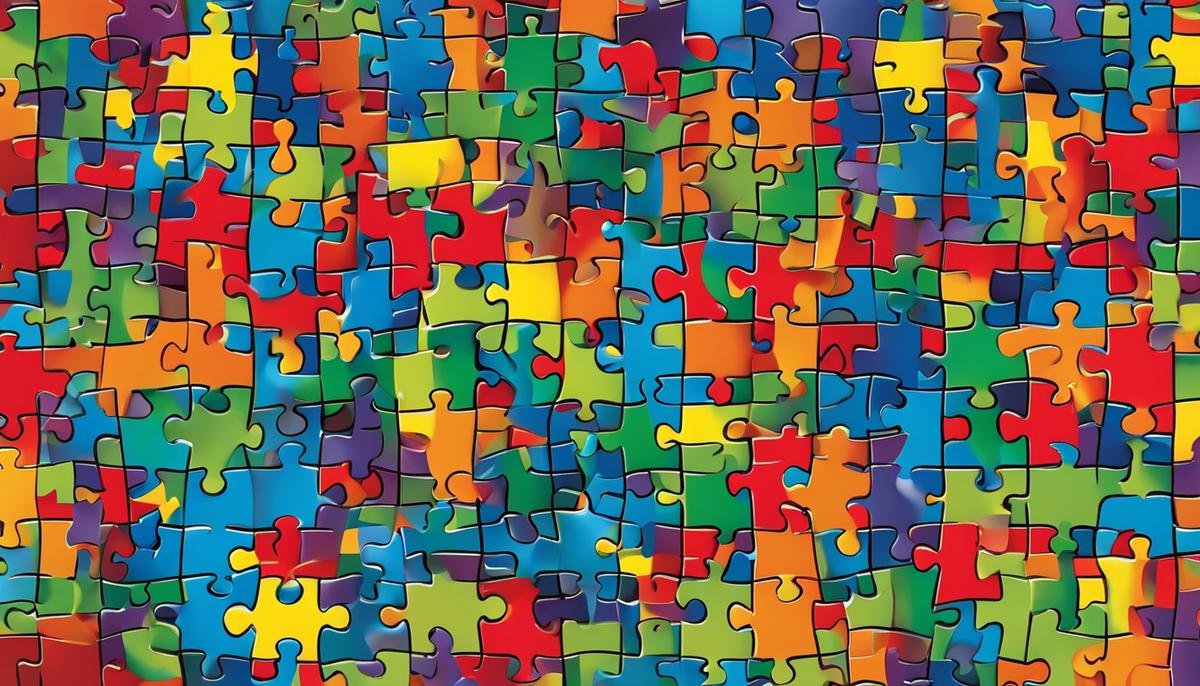
Autism Spectrum Disorder (ASD) is a complex condition that carries profound impacts on an individual’s life, and yet remains widely misunderstood. It moves past boundaries of race, ethnicity, and social standing, altering the life trajectories of affected children and their families. The journey to understanding and managing ASD brings families face-to-face with a myriad of challenges, including disparities tied to gender and race, and the desperate need for familial and communal support. Let’s journey into the heart of ASD and explore its diverse facets – from its core characteristics, gender disparities, and racial influences, to the indispensable role of community and family support.
Understanding Autism Spectrum Disorder
Unraveling Autism Spectrum Disorder: Understanding its Impact on Childhood
Understanding the complexities of childhood involves various aspects, and one increasingly common component is Autism Spectrum Disorder (ASD). This condition is in the spotlight due to sustained research, government initiatives, and heightened societal awareness. Topped off with heartening stories of children navigating life with autism, ASD is no longer shrouded in mystery. It’s time to delve into the heart of ASD and explore how it impacts the lives of children.
Initially, it’s crucial to make sense of what ASD is. Autism Spectrum Disorder is a developmental disorder that impacts the nervous system. The term “spectrum” signifies the broad range of experiences that individuals with autism may encounter. From mild to significant, these divergent experiences coincide with differences in social interaction, interests, and behavioral patterns.
Key to recognizing ASD is understanding it often presents itself within the first two years of life. Since this is a period characterized by rapid developmental changes, differences can be subtle and thus, easy to overlook. However, the most commonly observed signs include difficulties in social interaction, communication hitches, and repetitive behavior.
The influence of ASD on a child’s life is deeply profound, influencing how they interact with the world around them. Children with ASD might face challenges in understanding social cues or expressing their emotions adequately. Simple routines might be stressful for them, and they may develop specific interests indulged in repetitively.
However, it’s essential to remember that every child is unique. Children with ASD might display unique strengths such as exceptional focus, memory, or artistic abilities. This condition does not limit their potential, rather it offers a different lens to view and explore the world.
It’s also important to address that living with ASD comes with its share of hardship. An unwavering pillar of support, patience, and understanding from family, peers, and the community goes a long way in helping children with ASD to navigate these challenges.
After the diagnosis, a personalized treatment plan evolves around the child’s needs and capacities, which usually includes behavioral training, speech and occupational therapy. With the right interventions, children with ASD can learn to adapt and thrive, acquiring skills necessary to lead a successful life.
In conclusion, understanding Autism Spectrum Disorder paints a more empathetic and well-rounded picture of the varied hues of parenthood and childhood. Through this empathetic understanding, together we can lay the foundations of an inclusive and supportive society where children with ASD are empowered to breach their enclosures and live their fullest potential.
Remember, our children, autistic or not, are tender shoots of potential. Let’s nourish and nurture them, guide at every twist and turn, and, most importantly, love them with a heart that knows no boundaries!

Gender Disparity In Autism
Gender Differences in Autism Prevalence and Presentation
Autism Spectrum Disorder (ASD) is a neurodevelopmental condition that affects cognitive and social abilities, alongside a host of other characteristics. When it comes to gender differences in autism prevalence and presentation, research indeed points to some intriguing patterns.
Statistics show that boys are four times more likely to be diagnosed with autism than girls. This could lead someone to question, are boys more susceptible to ASD, or could it be that the current diagnostic criteria are more geared towards male presentation of autism? The diagnostic criteria was predominantly created based on studies conducted on males. As a result, the symptoms of ASD in females may often go unnoticed, under-recognized, or misdiagnosed due to different manifestation. In fact, some studies suggest that females with ASD may exhibit less repetitive behavior and might have less noticeable social difficulties than males.
It is also possible that girls with autism may simply appear different than boys with autism. For instance, girls may have more adaptive social communication skills and may mimic those around them to ‘blend in’, a phenomenon often referred to as ‘camouflaging’. This ability to camouflage their traits can also contribute to delayed diagnosis or misdiagnosis.
Autism presentation also varies within the same gender. There is significant heterogeneity among boys and girls with autism. Each child’s autism is unique in layout, just like a snowflake. Some might have apparent symptoms while others may not exhibit obvious signs at all, making it challenging to generalize.
It’s also worth noting that, traditionally, research has primarily focused on male subjects. As a result, our understanding of how ASD affects females is somewhat limited and requires more comprehensive attention.
Exploring gender differences in autism is not about pitting boys against girls. Instead, an understanding of these differences can help provide insights into individualized and gender-informed care. Fields such as education, psychology, and pediatric health can greatly benefit from recognizing these gender differences in autism manifestation.
Moreover, representation matters enormously for those impacted by ASD. This extends to their families, caregivers, and the broader community. By acknowledging the diverse presentations and experiences of all those on the spectrum — regardless of their gender — strides toward greater understanding, support, and inclusivity can be made.
As parents, caregivers, educators, and society as a whole, it is our collective responsibility to understand and respect each individual’s unique journey with autism. Our commitment to inclusivity and embracing neurodiversity can help create a community that recognizes, appreciates, and supports all. Together, let’s ensure no child is ‘lost in translation’ due to subtle variations in the manifestation of autism symptoms.

Race and Autism: An Examination
Examining the stark reality, race does indeed influence the diagnosis, treatment, and lived experiences of children with Autism Spectrum Disorder (ASD).
Being of a specific race, a child may face disparities in the medical support they receive, thus affecting their journey and lifestyle.
There’s considerable evidence showing racial disparities among children with ASD. Research indicates that children of color are often diagnosed with autism later than their white counterparts.
Some factors influencing this include the lack of access to quality healthcare, cultural stigma, and language barriers, among others.
Delays in diagnosis can lead to delays in treatment, depriving the child of critical early intervention.
Racial disparities extend to treatments too. Certain races, predominantly black and Hispanic children, are less likely to get intensive behavior interventions, medical evaluation, and appropriate care that are essential for their development.
Furthermore, they are more likely to be misdiagnosed with other conditions like Attention Deficit Hyperactive Disorder (ADHD), leading to inappropriate or ineffective treatments.
Sadly, these racial and ethnic disparities also extend into schools and communities. Studies suggest that schools with more racial diversity are less likely to provide comprehensive autism services and educational supports.
Children with autism from minority groups are also more likely to be excluded, misunderstood, or unfairly disciplined due to pre-existing racial biases, further affecting their development and quality of life.
Revealingly, the lived experiences of autism in diverse racial groups are far from being identical, influenced by racial, cultural, and socio-economic factors.
The lack of representation and understanding about autism in various races can lead to loneliness and increased anxiety for the individuals and their families.
While every child is unique and must be treated as such, it is crucial to shine light on the undeniable racial realities that affect our children with autism.
Helping them means challenging these disparities, educating ourselves, and advocating for more inclusive support systems.
The role of not just healthcare professionals but teachers, peers, and neighbors is vital.
We need more cross-cultural research in autism to understand the varying experiences and needs of diverse children better.
Culturally competent care is essential, alongside the creation of broader awareness about the variations in autism presentations across different races.
Building supportive environments that foster acceptance and cultivate each child’s potential is incumbent upon us all.
With empathy and understanding, we can ensure that no child with autism, irrespective of their race or ethnicity, is left behind or unfairly treated.
Let’s make sure, as a community, that we aren’t limiting our perspectives to just one part of the rainbow that is autism.
After all, in nurturing all affiliate colors, we are nurturing the entire spectrum.
Supporting diversity in autism isn’t just the right thing to do, it’s indispensable to building an inclusive and fair society.

Family and Community Support in Managing Autism
Having established a strong foundation around the understanding of Autism Spectrum Disorder (ASD), its diverse presentations, and varying implications based on gender and race, it’s crucial we touch on the significant influencers in the lives of individuals with ASD. These are mainly their family, community, and schools. Their roles are integral and symbiotic, setting the tone for the path to inclusivity, understanding, and support for children with ASD.
Family offers the first line of support. Their unconditional love and encouragement fuel the child’s self-confidence and self-esteem. They champion their cause, advocating for them when they can’t stand up for themselves. A family must become knowledgeable about ASD, its treatments, strategies for managing behavior, and community resources to fully cater to a child with ASD.
Creating a structured & predictable environment at home can help nurture a stable mental space for them. This includes maintaining routines, employing visual cues, giving advance warnings of changes, having a quiet, safe place for the child to relax, and including them in household chores. Families can also consider specialized therapeutic techniques, like Applied Behavioral Analysis and Social Stories, to teach social skills, communication, and self-care to children with ASD.
In the context of community, it plays an instrumental role in building an inclusive environment for people with ASD. Communities should strive to raise awareness about ASD, enhance understanding, and set aside stereotypes through initiatives, events, and educational programs. This fosters respect and acceptance, reducing social isolation for individuals with autism.
Social interactions also help build and improve communication skills and comprehension for people with autism. This can be achieved by involving people with ASD in local community activities and creating neighborly relationships. Helping others understand a person with autism – their unique ways of communication, their behaviors, and their struggles, can go a long way in establishing acceptance.
Schools, being the primary source of education and learning, have a substantial impact on children with ASD. Providing specialized professional training to educators to deal effectively with ASD is critical. Implementation of Individualized Education Programs (IEP) catered to the needs of children with ASD allows for a comprehensive learning environment.
Schools can also introduce peer training programs, where students without ASD are trained in understanding, interacting, and forming positive relationships with their peers with autism. This will not only increase acceptance but also foster a sense of belonging and camaraderie among students.
Carefully selected extracurricular activities and clubs designed with sensitivity towards ASD can encourage children with autism to explore and showcase their talents, focusing on their strengths rather than their differences.
In conclusion, fostering an environment of acceptance, understanding, and support for individuals with ASD shouldn’t be confined to specific sectors like family, community, or schools but should be a collective work in progress for each one of us. After all, the differences that set us apart are also the ones that bind us together in this diverse world of ours.

Indeed, autism is not a journey to tread alone, but one that requires the understanding, empathy, and advocacy of families, communities, and the society at large. By recognizing the nuanced gender disparities, racial influences, and the substantial value of a supportive network, we can make significant strides towards improving the experiences of children with autism and their loved ones. By expanding our understanding and striving for inclusivity, we can ensure that every child with autism gets the opportunity to live a fulfilling life, unhindered by societal limitations. Above all, let’s remember that at the core of any discussion on autism, race, and gender, we are talking about unique, vibrant individuals deserving of respect and true equality.




